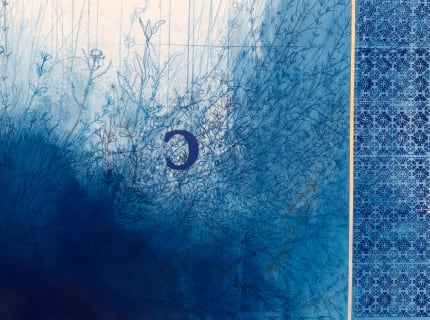Since the late 1970s, Ricardo Brey’s practice has focused on his research into the origins of humanity and humankind’s place in the world. Born in Cuba, Ricardo Brey worked briefly as an illustrator and graphic designer before exhibiting in the landmark 1981 group show “Volumen I” at the Centro de Arte Internacional in Havana. The exhibition brought Brey widespread critical attention and ultimately provided him with the opportunity to travel and exhibit internationally.
Ricardo Brey’s solo exhibition “Blue Shore” is a presentation of works made during the global Covid-19 pandemic. Unable to leave his home and studio in Ghent, Belgium, Brey turned to the color blue, which he associated with the sky and the sea, symbols of an unattainable expansiveness and freedom. In his works from this period, Brey adopts an almost exclusively blue palette, a significant departure from the earth-colored ochres and rusty reds of previous works on paper. Just as the artist moves fluidly across various mediums, so do variegated blues wind through his two and three dimensional works. The works on paper in the exhibition reflect Brey’s rigorous engagement with a wide range of media––including found objects, silverpoint, gouache, and ink––as well as his range with scale, from delicate drawings to massive, saturated works on paper. Throughout his career Brey has often worked on a single theme across various mediums. Here, a panoply of blues emerges not only on wall-hung works, but in sculptures and Brey’s unique Boxes. In “Cielo” (2021), Brey deconstructs practices that humans have developed to understand the heavens. Inside the Box rests a large dark cast of a tortoise’s shell with stars affixed to its underside. By resting the deconstructed pieces of an orrery within the tortoise shell, Brey not only forms a physical representation of the heavens, but also creates a multitude of thematic contrasts between Western and Eastern cosmologies, science and nature, and ancient and modern forms of thought. Similarly, working blues into his earlier series of uncanny, classically inflected. “Kouros” sculpture series gives the works a new dynamism and distinct emotional register. The kouroi of antiquity were free-standing sculptures of nude male youths that began to appear in the Archaic period in Greece. Brey’s kouroi often consist of a bird’s skull formed from wood and clay mounted on a metal rod along with carefully arranged found elements. “Osain” (2021) gets its name from a Santería divinity, or orisha, associated with herbs and healing. The blending of cultural iconographies achieved via a rigorous chromatic, formal, and conceptual engagement is emblematic of Brey’s artistic ethos. Refuting reductive binarisms, Brey’s art surmounts divisions between myths, religions, and systems of thought and value to champion a holistic approach to understanding the human condition.
A child of the Cuban Revolution, Ricardo Brey first received widespread critical attention in 1981 following his involvement with and inclusion in the landmark exhibition “Volumen I” at the Centro de Arte Internacional in Havana, contributing to a dynamic, experimental artistic scene in Cuba. Through the 1980s, Brey continued to mine Afro-Cuban traditions and colonialism’s legacy throughout Latin America. In 1992, at the invitation of Belgian curator Jan Hoet, Brey participated in Documenta IX with a monumental installation consisting of readymades and other salvaged objects that invoked a hybrid, transcultural mythology. Brey’s interest in harnessing the associative potential of found objects continued throughout the 1990s and informs his practice today. Since the early 2000s, the artist’s interest in the natural world has catalyzed projects like “Universe” (2002–2003), consisting of over 1,000 drawings illustrating an “entire” universe—including many species of fish, birds, insects, and plants—its ongoing supplement “Annex” (2003–2016), and “Every Life is a Fire” (2009–2015), a series of intricate boxes that unfold to reveal artistic microcosms of the observable world, which were included in the 2015 Venice Biennale curated by Okwui Enwezor.
...
Read full article at dreamideamachine.com.

